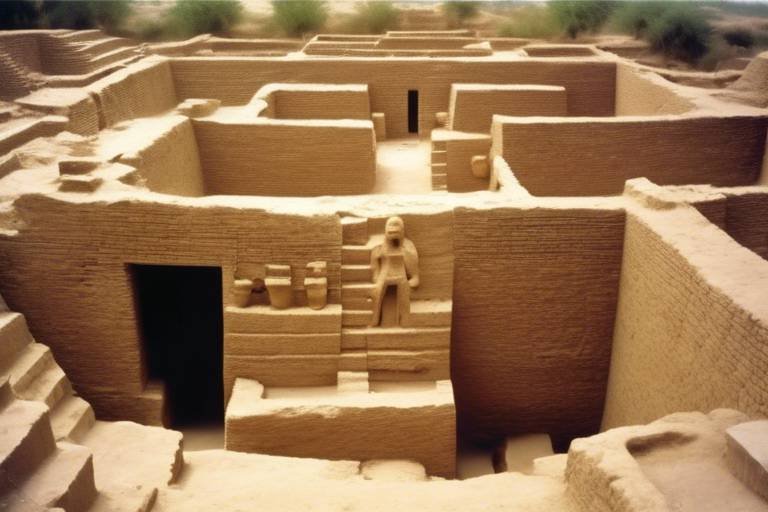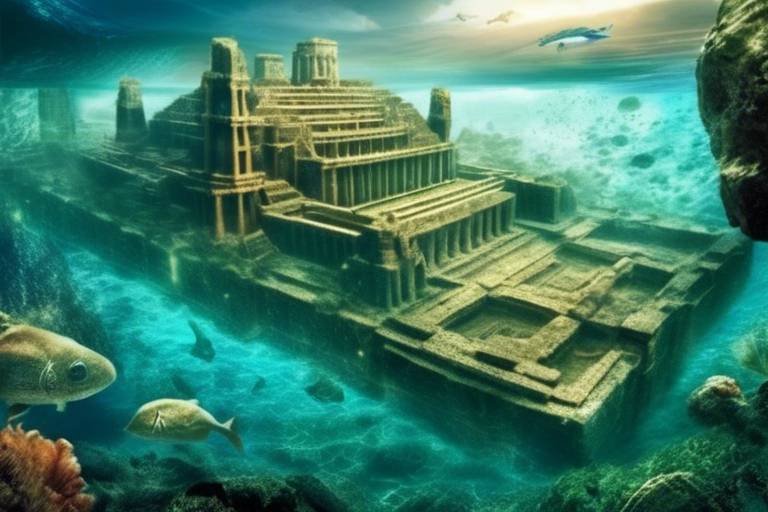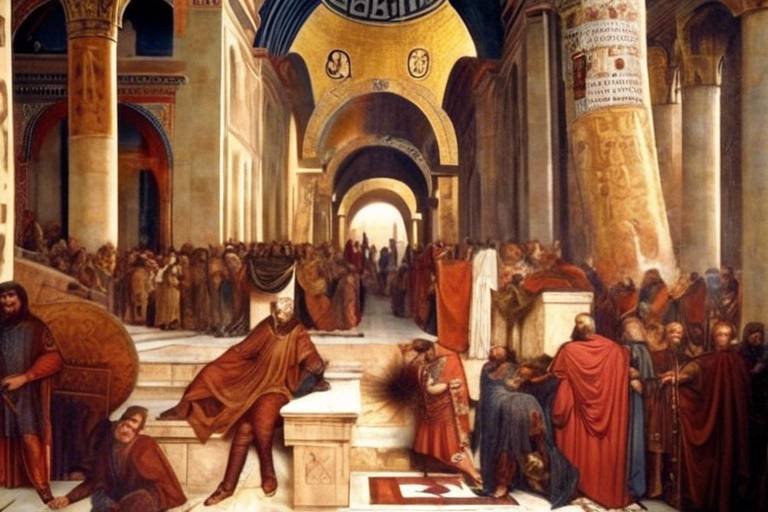The Secrets of the Lost Treasures of the Carthaginians
Embark on a journey through time and mystery as we delve into the secrets of the lost treasures of the Carthaginians. This ancient civilization, renowned for its wealth and maritime dominance, holds a trove of riches shrouded in enigma, waiting to be discovered by the intrepid souls brave enough to seek them out.
Imagine the thrill of uncovering ancient artifacts that have weathered the tides of history, revealing glimpses of a bygone era filled with opulence and intrigue. The tales of the Carthaginians' treasures have captivated generations, sparking countless expeditions in search of the elusive bounty that lies hidden beneath the sands of time.
As we peel back the layers of mystery surrounding the lost treasures of Carthage, we are met with a tapestry of myths, legends, and whispered rumors that speak of untold riches waiting to be claimed. Gold, silver, precious gems, and priceless artifacts beckon to those who dare to brave the unknown in pursuit of fortune and glory.
Join us as we unravel the secrets that have long eluded discovery, piecing together the puzzle of Carthage's fabled wealth and the fates that befell those who sought to possess it. The allure of hidden riches, coupled with the thrill of adventure, promises an expedition like no other, where each step taken brings us closer to unlocking the mysteries of a lost civilization.

History of the Carthaginians
The Carthaginians, an ancient civilization with a rich and storied history, rose to prominence as a maritime power in the Mediterranean. Founded around 814 BC by Phoenician settlers, Carthage quickly established itself as a key player in trade and commerce, thanks to its strategic location on the North African coast.
Known for their seafaring skills and naval prowess, the Carthaginians built a vast empire that stretched across North Africa, Sicily, Sardinia, and parts of Spain. Their dominance in trade routes allowed them to amass great wealth through the exchange of goods such as textiles, metals, and agricultural products.
However, the prosperity of Carthage also brought conflict, particularly with the rising power of Rome. The Punic Wars, a series of conflicts between Carthage and Rome, ultimately led to the downfall of the Carthaginian civilization. The Third Punic War culminated in the destruction of Carthage in 146 BC, marking the end of an era.
Despite their defeat, the legacy of the Carthaginians lives on through their impressive architectural achievements, advanced military tactics, and intricate trade networks. The remnants of their civilization continue to intrigue historians, archaeologists, and treasure hunters alike, fueling the ongoing quest to unravel the mysteries of their lost treasures.

Legendary Treasures of Carthage
Legend has it that the ancient city of Carthage was home to legendary treasures beyond imagination. Stories passed down through generations speak of vast hoards of gold, silver, and precious gems hidden within the walls of the city, waiting to be discovered by brave adventurers. These treasures are said to hold not only immense material wealth but also great historical and cultural significance, offering a glimpse into the opulence and power of the Carthaginian civilization.
Among the most sought-after artifacts are the jeweled crowns of Carthaginian rulers, said to be adorned with rare gems of exquisite beauty. Tales of intricate golden ornaments, intricately crafted by skilled artisans, add to the allure of these fabled treasures. The Carthaginians were known for their exquisite craftsmanship and their ability to create objects of unparalleled beauty, making their treasures all the more coveted by those who seek to uncover their secrets.
Furthermore, ancient texts and inscriptions hint at the existence of sacred relics and ceremonial artifacts that were believed to hold mystical powers. These relics, shrouded in mystery and surrounded by tales of supernatural occurrences, have captured the imagination of treasure hunters and historians alike, fueling the desire to unearth the hidden riches of Carthage.
Legends also speak of secret underground chambers and hidden vaults where the most precious treasures of Carthage were safeguarded from invaders and plunderers. The intricate network of tunnels and passageways is said to be booby-trapped with deadly mechanisms to deter any who dare to trespass in search of the coveted riches. The enigmatic nature of these hidden chambers only adds to the mystique and danger associated with the legendary treasures of Carthage.

The Siege of Carthage
The Siege of Carthage marked a pivotal moment in the history of the ancient city, leading to its eventual downfall at the hands of the Romans. The conflict between Rome and Carthage culminated in a series of brutal battles, culminating in the siege and destruction of the once-great Carthaginian civilization. As the Roman legions closed in on the city, the Carthaginians fought fiercely to defend their homeland, but ultimately succumbed to the overwhelming military might of their adversaries.
During the siege, the fate of the Carthaginian treasures became shrouded in mystery. Some believe that in a desperate attempt to safeguard their riches from the invading Romans, the Carthaginians concealed their most valuable artifacts in hidden vaults or secret locations, hoping to preserve their legacy for future generations. Others speculate that the treasures were looted and plundered by the victorious Romans, scattering them across the Mediterranean and beyond.
Despite the passage of centuries, the exact whereabouts of the lost treasures of Carthage remain a subject of fascination and intrigue for historians, archaeologists, and treasure hunters alike. The siege not only marked the end of an era for Carthage but also set the stage for the enduring mystery surrounding the fate of its legendary riches.

Explorers and Treasure Hunters
Explorers and Treasure Hunters have long been fascinated by the mysteries surrounding the lost treasures of the Carthaginians. These daring individuals, driven by a thirst for adventure and a passion for uncovering history's secrets, have embarked on perilous journeys in search of the fabled riches rumored to be hidden in distant lands and beneath the waves of the Mediterranean Sea.
One of the most famous treasure hunters in Carthaginian history is the legendary explorer, Heinrich Schliemann, known for his discovery of the ancient city of Troy. Schliemann's expeditions inspired a new generation of adventurers to follow in his footsteps and seek out the lost treasures of civilizations long past.
Modern-day treasure hunters equipped with state-of-the-art technology and historical knowledge continue to scour the earth in pursuit of Carthaginian artifacts and riches. From underwater archaeologists exploring sunken Carthaginian ships to land-based expeditions searching ancient ruins, these treasure hunters spare no effort in their quest for the elusive treasures of the Carthaginians.
Despite facing numerous challenges, from treacherous terrain to rival treasure hunters, these intrepid explorers remain undeterred in their mission to unravel the mysteries of Carthage and bring to light the hidden wealth of this ancient civilization. Their relentless pursuit of the Carthaginian treasures serves as a testament to the enduring allure and fascination of lost riches waiting to be discovered.

Archaeological Discoveries
Archaeological discoveries related to the treasures of the Carthaginians have unveiled a wealth of information about this ancient civilization. Excavations have unearthed a myriad of artifacts, ranging from intricately crafted jewelry to pottery and coins, shedding light on the daily life and trade practices of the Carthaginians. Notable findings include well-preserved shipwrecks off the coast of modern-day Tunisia, providing valuable insights into their maritime activities and the goods they transported across the Mediterranean. Additionally, tombs containing funerary offerings and inscriptions have offered clues to the religious beliefs and burial practices of the Carthaginians, hinting at the significance of the afterlife in their culture.

Legends and Myths
Legends and myths surrounding the treasures of the Carthaginians have woven a tapestry of intrigue and mystery, captivating the imagination of treasure hunters and historians alike. Stories of cursed gold, hidden vaults, and ancient relics shrouded in secrecy have fueled the quest to uncover the lost riches of this ancient civilization. The allure of these fabled treasures continues to beckon adventurers to embark on daring expeditions in search of the legendary wealth that is said to lie buried beneath the sands of time.

The Curse of Carthage
Legend has it that the treasures of Carthage are not just hidden, but cursed as well. The Curse of Carthage is a tale whispered among treasure hunters and historians alike, warning of the dire consequences that befall those who dare to seek the lost riches of the ancient civilization. It is said that a dark shadow looms over anyone who dares disturb the resting place of the Carthaginian treasures, bringing misfortune, tragedy, and even death upon those who dare to defy the curse.
Stories of treasure hunters disappearing without a trace, ships vanishing into thin air, and inexplicable accidents plaguing those who come too close to the fabled riches have only served to fuel the mystique surrounding the Curse of Carthage. Some believe that the curse is a punishment from the ancient gods, a warning to all who covet the wealth of the Carthaginians to turn back before it's too late.
Despite the warnings and the ominous tales that shroud the treasures of Carthage, there are still those who are undeterred by the superstitions and legends. The allure of untold riches and the thrill of the hunt are powerful motivators, driving adventurers to risk it all in pursuit of the elusive treasures that lie hidden beneath the sands of time.

Preserving Carthaginian Heritage
Preserving the rich heritage of the Carthaginians is a task that requires dedication and careful planning. Efforts to safeguard the cultural legacy of this ancient civilization involve a variety of initiatives aimed at protecting artifacts, archaeological sites, and historical records that shed light on their way of life. Conservation projects focus on maintaining the integrity of ancient ruins, such as the remnants of Carthage itself, to ensure that future generations can learn from and appreciate the achievements of this once-great civilization.
One key aspect of preserving Carthaginian heritage is the documentation and study of artifacts discovered through archaeological excavations. By cataloging and analyzing these objects, researchers can piece together the puzzle of Carthaginian society, economy, and beliefs. Museums play a crucial role in displaying these treasures to the public, allowing visitors to connect with the past and gain a deeper understanding of Carthaginian culture.
Furthermore, educational programs and outreach efforts aim to raise awareness about the significance of Carthaginian heritage and the importance of its preservation. By engaging with schools, communities, and tourists, advocates for Carthaginian culture hope to instill a sense of pride and respect for the achievements of this ancient civilization.
In addition to physical artifacts, efforts to preserve Carthaginian heritage also extend to the digital realm. Digital archives and databases store valuable information about Carthaginian history, providing researchers and enthusiasts with access to a wealth of knowledge about this enigmatic civilization. By leveraging technology, experts can ensure that the legacy of the Carthaginians remains alive and accessible in the modern age.
Frequently Asked Questions
- What are the Lost Treasures of the Carthaginians?
The Lost Treasures of the Carthaginians refer to the wealth and valuable artifacts that belonged to the ancient Carthaginian civilization, known for their maritime trade and military power. These treasures, which include gold, silver, gems, and historical relics, have captured the imagination of explorers and historians for centuries.
- Are the Carthaginian treasures real?
Yes, the Carthaginian treasures are real, with historical accounts and archaeological evidence supporting the existence of their wealth. While some treasures have been discovered through archaeological excavations, many are still believed to be hidden or lost, adding to the mystique and allure of these ancient riches.
- Is there a curse associated with the Carthaginian treasures?
Legend has it that a curse looms over those who seek the Carthaginian treasures, with tales of misfortune and tragedy befalling those who dare to disturb the ancient relics. While the curse remains a part of the folklore surrounding the treasures, it adds an element of mystery and caution to the quest for these elusive riches.



















